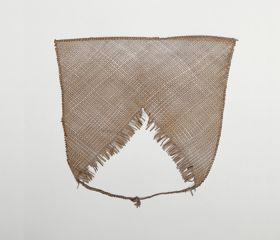Eye-shade taumata or taupoo
Place: Tahiti & Society Islands
Category: Clothing
wood, fara (pandanus) fibre, Tahiti and the Society Islands, l. 25 cm, w. 29 cm, Inv. Oz 399
Humphrey No. 52: ‘a Tumataw, Bonnet or Sun-Shade of a very simple make, formed of matting, worn by the Women of the Society Isles.’
The eye-shade consists of a fine weave of fara fibres (Pandanus) reinforced by a trapeze-shaped frame made of thin wooden sticks. The loosely interwoven wooden sticks form the front and the side rims of the eye-shade, while the rear rim is cut out in a V-shape, with no stick reinforcement, so that it nestles softly against the forehead. The plaited strips, 2 to 3 mm wide, protrude by about 2 cm into the V-cut. From the weave at the two rear ends of the stick reinforcement, two braided twisted strings of the same material each protrude 10 cm. These serve to fasten the eye-shade at the back of the head. Finely plaited eye-shades such as the Göttingen example tended to be the exception (Bunzendahl 1935: 137). They were apparently worn mainly by women (Kaeppler 1978a: 131). Headbands made of split coconut palm leaves served more frequently as protection from the sun. Whenever needed, they could be fashioned within a few minutes by the women, and were mostly discarded again at sunset (cf. Banks 1896: 153f.). Gundolf Krüger
Sources
Banks, Joseph, Journal of the Right Hon. Sir Joseph Banks During Captain Cook’s First Voyage in H.M.S. Endeavour in 1768-71 to Terra del Fuego. Otahite, New Zealand, Australia, the Dutch East Indies etc., by Sir Joseph D Hooker, London, 1896.
Bunzendahl, Otto, Tahiti und Europa: Entdeckungsgeschichte der Gesellschaftsinseln, Studien zur Völkerkunde, Leipzig, 1935, vol. 8.
Kaeppler, Adrienne L, ‘Artificial Curiosities’ Being An Exposition of Native Manufactures Collected on the Three Pacific Voyages of Captain James Cook RN [Exhibition catalogue], Bishop Museum Press, Honolulu, 1978a.

